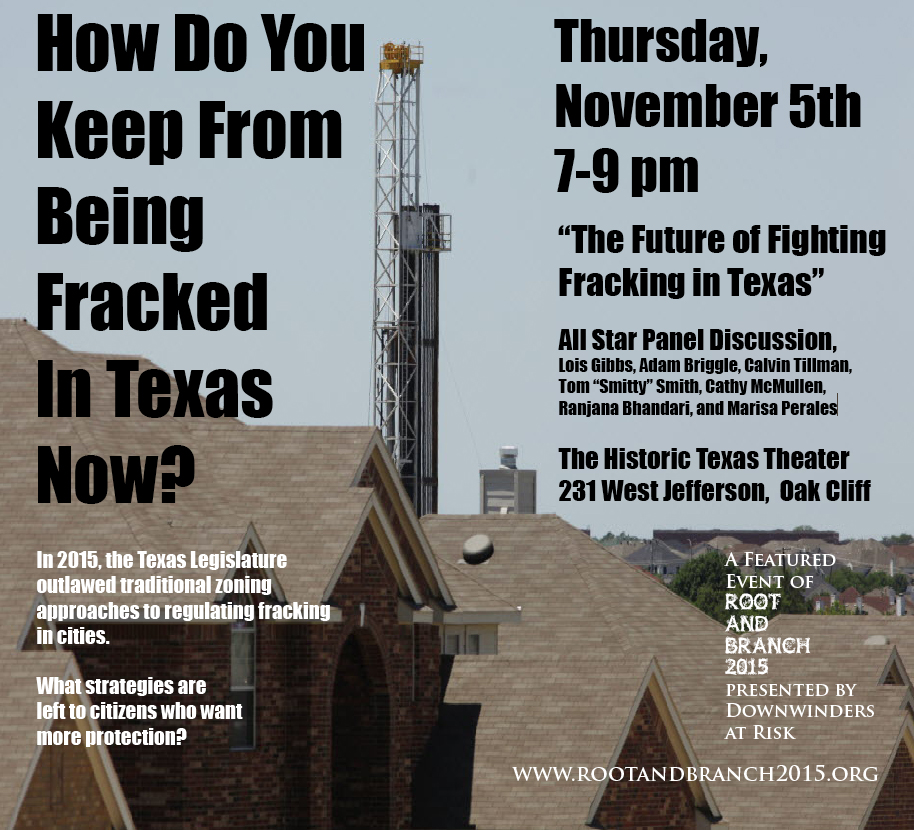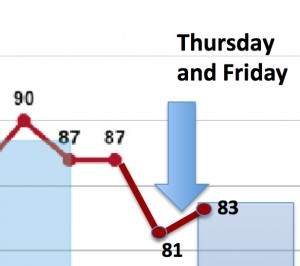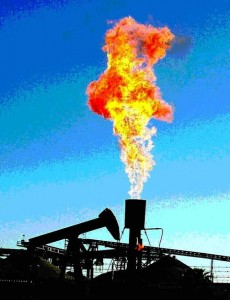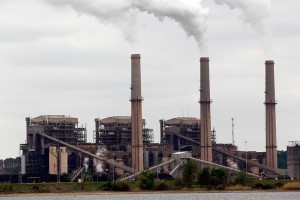Citizen Action
“Help: We Live in Texas.” Our Response to Today’s TCEQ Vote on the DFW Air Plan
(Dallas)— “Help Us: We Live in Texas.”
That’s the plea of a video released today by a local clean air group claiming the state has so intentionally sabotaged Dallas-Fort Worth anti-smog efforts that residents now need EPA to take over the job.
“Texas is as likely to enforce the Clean Air Act in 2015 as Mississippi was to enforce the Voting Rights Act in 1965,” said Downwinders at Risk’s Director Jim Schermbeck, echoing a line in the video.
The group posted the 2:42 minute piece, titled “SOS @EPA” in response to this morning's vote by the Texas Commission on Environmental Quality (TCEQ) to move forward with a new anti-smog plan for DFW that the Commission has already been told by EPA falls short of legal and regulatory requirements.
In the video, footage from a Downwinders’ street action calling for help at EPA Regional Headquarters in downtown Dallas November 5th is spliced with facts about DFW’s 20 years and counting chronic smog problem. Central to the group’s charge is the state’s unwillingness to put new controls on major sources of industrial air pollution like the Midlothian cement kilns, East Texas coal plants, and gas facilities – despite the fact their own air modeling shows those controls could bring smog down enough to comply with the Clean Air Act.
Today’s vote by the TCEQ is the second in 12 months concerning the same DFW air plan. Its goal is to get from an average of 83 parts per billion (ppb) of smog in 2015 down to the current federal standard of 75 ppb by 2017. However, the state only estimates a best-case result of almost 78 ppb. Despite that shortfall, there are no new pollution controls required of any major sources. Over the last 20 years, the state has written five anti-smog plans for DFW. None has accomplished its goal on deadline, and regional smog levels actually rose this year.
Besides once again failing to hit is mark overall, the EPA has already told the State its formal assessment of modern pollution controls for those major sources needed revisiting to be legal. TCEQ refused to comply with EPA and today’s plan contains exactly the same assessment as the one EPA has already said isn’t sufficient, making that part of the plan instantly illegal. Although EPA gives state governments authorization to write smog plans for their own metropolitan areas, it still has final approval based on criteria listed in the Clean Air Act.
One of the points made in the group’s video is that studies by local hospitals have shown DFW childhood asthma rates to be as much as four times the state average and over twice the national average, making the need for cleaner air imperative.
“The health of seven million Dallas-Fort Worth residents is being held hostage by a state government hostile to the goal of clean air. Only federal intervention can save us,” said Schermbeck.
The video can be found at Downwinders at Risk’s website (downwindersatrisk.org), it’s Facebook page, twitter account (@cleaner air) and the group’s YouTube channel (Downwinders’ TV).
__________________________________________________________________________________________
SEND EPA ADMINISTRATORS A MESSAGE TO REJECT THE STATE'S PLAN AND WRITE ONE OF ITS OWN:
https://www.downwindersatrisk.org/featured-citizen-action/
SIGN THE CHANGE.ORG PETITION:
____________________________________________________________________________________
LIKE THIS VIDEO? LIKE OUR WORK? THINK IT'S IMPORTANT?
THEN PLEASE MAKE A TAX-DEDUCTABLE CONTRIBUTION TO DOWNWINDERS BEFORE DECEMBER 31st.
________________________________________________________________________________________
WHY?
It might be hard to believe, but despite being the nation’s fourth largest metropolitan area, and being in constant violation of the Clean Air Act for smog since 1991, and having higher annual smog numbers than Houston, and being singled out by EPA as one of only a handful of areas expecting to STILL be in violation of the Clean Air Act in 2025, there’s still only one professional staff person devoted to cleaning up DFW air: the staff person you pay for when you contribute to Downwinders at Risk.
Besides community organizing on the ground, Downwinders also had to go out and build a new committee of local officials concerned about dirty air after the traditional regional air quality planning process broke down. That committee produced a first-ever study showing how new pollution controls on the kilns, coal plants, and compressors could bring smog levels down enough to comply with the Clean Air Act. Our study was used by the Dallas Commissioners Court to pass a resolution requesting new controls on the East Texas coal plants in October. Had it not been for our new committee, there would have been no local officials involved in the DFW air quality planning process at all, and noaccountability for a state government that isn’t interested in our lungs.
Want to get just basic information about DFW air pollution? There are no dedicated environmental beat reporters left in DFW. Downwinders fills this gap as well, providing the only source of reliable and timely information on DFW air quality issues.
Need technical or organizing training? We do that too. Many of you know we just sponsored our first conference – the four-day Root and Branch Revue, featuring a graduating class of 70 grassroots activists from our first “University of Change.”
When you give to Downwinders, you fund the last line of defense between your lungs and a state government that doesn’t believe smog is that bad for you.
And when you give to Downwinders, you know you’re giving to a group with a two decade proven track record of getting results.
That’s our pitch. We get your donation. You get our best effort at protecting your lungs.
On behalf of myself, and the Downwinders at Risk board, thank you for your consideration.

Jim Schermbeck
Director, Downwinders at Risk
State Re-Submits Illegal DFW Smog Plan, Dares EPA to Reject It

(Dallas)– In an unprecedented rebuke to the Environmental Protection Agency, Texas has refused to provide critical data EPA says it needs to approve the state’s controversial anti-smog plan for DFW, which requires no new pollution controls despite more than two decades of chronic bad air.
Texas' refusal to cooperate with EPA puts its plan, scheduled to be approved by the Texas Commission on Environmental Quality December 9th, on a collision course with the federal agency.
Although EPA gives state governments authorization to write smog plans for their own metropolitan areas, it still has final approval based on criteria listed in the Clean Air Act. EPA disapproval of the State's DFW plan would trigger the possibility of a federal takeover of the air planning process.
That would be fine with local air quality activists, who've been pushing for the EPA to take over the job of writing a new clean air plan for North Texas since the State unveiled its first draft last year. They say TCEQ's official position that smog isn't harming public health means the Commission can't be trusted to write an effective anti-smog plan. When the state announced a plan imposing no new controls on any sources of air pollution despite DFW being in continual violation of the Clean Air Act for the last quarter century, they feel they were proven right.
"It's as if the state is too embarrassed to do what EPA is asking for fear of finding facts that don't match its ideology," said Jim Schermbeck, Director of the local clean air group, Downwinders at Risk.
He noted among the most important missing items in the State’s final plan published November 20th was a "Reasonably Available Control Technology"(RACT) study for the Midlothian cement plants, as well as answers to the impact of controls on other sources like the East Texas coal plants and oil and gas facilities that EPA posed in its eleven pages of official comments on the first draft last February. Application of modern pollution controls to all major sources of air pollution in a smog-plagued region is a key component of the Clean Air Act.
In official comments last February, EPA specifically requested the state perform a new study of what kind of smog controls should be required of the three Midlothian cement plants immediately south of DFW. EPA warned lack of such a study would mean the plan would be disapproved:
"Failure to conduct a thorough RACT analysis for cement kilns which would include appropriate emission limits would prevent us from approving the RACT portion of the attainment plan submittal.”
By turning-in the same version of the technology review originally criticized by EPA, without any new additional analysis, the TCEQ began a bureaucratic game of "Chicken," daring the EPA to deny approval.
"If you're EPA, I don't see how you take this any other way than a big raised middle finger from Austin," said Schermbeck. "The question is: What's EPA gonna do about it now?"
Also missing in the final state version are any responses to other EPA's concerns and questions about the plan's chances of actually lowering smog levels and the possibilities of reducing smog with new controls on other sources, such as,
“How would a reduction in NOx emissions from utility electric generators in the counties closest to the eastern and southern boundaries of the DFW area impact the DFW area?”
EPA was already openly skeptical about the chances of the state’s plan succeeding without requiring any additional cuts in pollution. Stating “it would be difficult to see” how the plan meets its required 2017 deadline, the Agency concluded “we believe it is likely that additional reductions will need to be included to demonstrate attainment.”
TCEQ’s resubmitted plan doesn’t have any additional reductions. Failure of a state plan to show how it can reach the smog standard by 2017 would be cause for EPA to assume the job itself.
Evidence suggests the state is purposely overlooking the air quality benefits of controls on large industrial sources of air pollution affecting DFW.
In late October, Downwinders at Risk released a new study of its own. It paid for University of North Texas engineers to build a clone of the State’s DFW air computer model and run a series of control scenarios the state hasn’t performed in almost a decade. Using the TCEQ’s own numbers it showed new controls on the cement kilns, coal plants, and gas compressors in the Barnett Shale would lower smog levels enough to meet the current federal smog standard. DFW hasn’t met a federal standard for smog since once was created in 1991.
Dismissing the results as “limited,” TCEQ officials nevertheless agreed with them – since they were based on their own model. The State argues those new controls are not yet technically or economically feasible – despite their being commonplace around the world, in the US, and even in Texas.
This question is one of the keys to the standoff with EPA: are the proposed new controls for industry “Reasonably Available” or not? If they are, they must be included in the air plan. If not, they remain off the table. EPA makes the first call on a definition, and any aggrieved party can sue to expand or contract it.
Because it’s a national hot spot for smog, DFW is only one of a handful of US metro areas that even had to submit a clean air plan this last cycle. EPA computer modeling predicts the area will still be in violation of the Clean Air Act in 2015 unless significant reductions in pollution are made.
This summer saw the North Texas regional smog average rise twice in one hot August week, retreating from gains made during last year’s cooler, wetter summer. DFW once again has higher annual smog levels than Houston. Both cities remain well above the current standard.
According to the American Lung Association, the 10 county DFW “non-attainment” area for smog includes approximately 150,000 asthmatic children, 350,000 adults with asthma, and over 600,000 adults with cardiovascular disease or COPD – all of whom are at risk from the region’s bad air.
“The lungs and lives of seven million residents are being held hostage by a state government that doesn’t think smog is a problem and isn’t willing to require new pollution controls to reduce it, “ Schermbeck pleaded
“Expecting the State of Texas to enforce Environmental laws in 2015 is like expecting the State of Mississippi to enforce Civil Rights laws in 1965. Our only hope is federal intervention.”
First Public Strategy Session for Texas “Fractivists” Since State Legislature Stripped Cities of Zoning Authority
 What: “The Future of Fighting Fracking in Texas”
What: “The Future of Fighting Fracking in Texas”
When: 7-9 pm Thursday, November 5th
Where: Historic Texas Theater in Oak Cliff, 231 West Jefferson
Who: Regional and Statewide Activists, Attorneys and Organizers
(Dallas)— A new alliance of groups fighting for more protective fracking regulation in Texas is using a Dallas environmental conference to host the first statewide strategy session responding to the passage of HB40 by this year’s state legislature.
Dubbing itself the “Texas Grassroots Network,” organizers include key members of local groups in Arlington, Denton, and Mansfield. Since their first meeting during the summer, they’ve also received calls from South Texas residents who live in the Eagle Ford gas and oil field. Their aim is to create something Texas has never had – a statewide coalition of grassroots groups tackling the same industry and the same problems caused by that industry setting up shop too close to people.
On the evening of Thursday, November 5th, they’re taking over Dallas’ historic Texas Theater to begin what they say will be a wide-ranging and free wheeling discussion about what the best options for those who don’t want to live side-by-side with drilling rigs in light of the legislature’s restrictions on local zoning.
“It’s time to regroup and come up new ideas and strategies about how to stop irresponsible fracking,” said Tamera Bounds, of Mansfield Gas Well Awareness. “We need to use our anger of what the legislature did to fuel new efforts and recruit new supporters. Most Texans want local control of fracking. Our job is to build a statewide movement reflecting that.”
“The Future of Fighting Fracking in Texas” is the second featured event of local clean air group’s Downwinders at Risk’s four-day floating conference, called “The Root and Branch Revue.” Other conference events include an evening of “environmental comedy” with Bar Politics, a day of workshops aimed at sharpening activist skills, and an attempt to construct “the world’s largest S.O.S” outside EPA Regional Headquarters in downtown Dallas. Lois Gibbs, of Love Canal fame, is the featured guest.
But it’s Thursday’s panel discussion and a follow-up on Saturday that could potentially have the biggest impact on the Texas environmental movement. Many opponents of urban fracking are still reeling from the state’s ban on local zoning restrictions last spring. There hasn’t yet been a coordinated or articulated response. Organizers of the Texas Theater discussion aim to fix that.
Participating will be some of the most high-profile regional fractivists, including Bounds, who’ll moderate, Adam Briggle and Cathy McMullen from Denton, Ranjana Bhandari form Arlington, and former DISH mayor Calvin Tillman. Joining them onstage on stage will be Public Citizen/Texas staffer Tom “Smitty” Smith, Austin-based environmental attorney Marisa Perales, and Lois Gibbs herself.
“HB 40 has forced us to look beyond our own city limits and find new ways to organize residents,” said Bounds. This public strategy session is one of he first steps we need to do that and regain momentum.”
DFW One of Only Ten Areas Nationwide Not Expected to Meet New Smog Standard by 2025
 There was a lot of coverage of last week's announcment of a new, more protective national smog standard by EPA. Most of it centered on the reaction by both sides that it was either not enough progress (public health advocates), or Western Civilization was about to collapse under the weight of all the controls necessary to meet the standard (National Chamber of Commerce, et al.).
There was a lot of coverage of last week's announcment of a new, more protective national smog standard by EPA. Most of it centered on the reaction by both sides that it was either not enough progress (public health advocates), or Western Civilization was about to collapse under the weight of all the controls necessary to meet the standard (National Chamber of Commerce, et al.).
But if you read deeper into the articles, many of them mentioned computer modeling EPA had already done that demonstrated, given current trends, only 14 counties, representing 10 separate areas, wouldn't be able to meet the new standard by the target year of 2025. Unfortutantely, none of those articles mentioned which 14 counties, or which 10 areas.
Now, given all that you already know about our state and regional track record for meeting clean air deadlines, your first question might be: how many of those are in Texas? We'll give you a minute or two to start a pool and pick a number….
And the answer is: Three. Brazoria and Harris Counties in the Houston "non-attainment area" for smog, and Tarrant in DFW's non-attainment area. (The ten areas are: Baltimore, Dallas-Fort Worth, Denver, Fort Collins, Houston, Louisville, Milwaukee, New Haven, New York, and Pittsburgh).
Of course, for the purposes of regional smog record-keeping, EPA doesn't separate Tarrant County numbers from Dallas County, or Denton County, or any of the other nine counties in the non-attainment area. If one monitor is out of compliance in the area, the whole region is considered in violation. So EPA is conceeding that both DFW and Houston will still continue to be in continual violation of the Clean Air Act for another decade.
This is discouraging but not surprising. The State refuses to put new-generation controls on large major polluters like the Midlothian cement plants, East Texas coal plants, and gas production facilities, while painting the rosiest scenarios with its own modeling.
But this new revelation means it's that much more important to get EPA to override the state and act now to include controls on those major polluters, while the current smog plan is in the pipeline. It may be the only chance we have in the next 5-10 years to adequately address these sources. This can only be done if the EPA decides to revoke Texas' authority to write and implement these plans – to commit to a Federal Implementation Plan of its own.
PLEASE….
1) Sign our Change.Org petition urging the EPA to reject the state's clean air plan for DFW and substitute one of its own, and
2) Send an e-mail to the Chief EPA administrator in Washington and the Regional Administrator here in Dallas saying you want them to take responsibility for a new DFW air plan.
Thanks.
Next Week is Giving Day: Help Us Bring Lois Gibbs to Town
 As many of you already know, Next Thursday, September 17th is North Texas "GIVING DAY."
As many of you already know, Next Thursday, September 17th is North Texas "GIVING DAY."
They'll be an All-Star panel on the future of fighting fracking in Texas after HB40.
They'll be a rally at EPA headquarters to demand the Agency enforce evnironmental laws.
They'll be an entire day of workshops on how to be a better activists. Want to know how to do your own air or water sampling? Get better media coverage? What industrial poisons affect you in DFW? You can learn from the experts.
It looks like they'll even be a comedy troupe review taking aim at DFW's air pollution.
But we need your help to pull this first-ever conference off and do it right. Our goal is to raise $7500 next Wednesday to help cover the expenses of our speakers, book our venues, and provide food and materials.
We're STILL the only group solely focused on DFW air quality.
We're STILL the only group with a full time staffer devoted to your lungs.
And we're STILL completely dependent on local contributions from our supporters to stay in business
 EALLY need you to take the time next Thursday to give generously to an effort that affects the very air you breathe. And keep on the lookout in your mailbox for news about our first-ever grassroots conference for people just like you.
EALLY need you to take the time next Thursday to give generously to an effort that affects the very air you breathe. And keep on the lookout in your mailbox for news about our first-ever grassroots conference for people just like you.
Going Backwards: DFW’s Annual Smog Average Went Up Twice in Two Days Last Week
 State officials and industry PR types thought they'd caught a break last summer when two things produced a much lower annual smog average, called a "Design Value."
State officials and industry PR types thought they'd caught a break last summer when two things produced a much lower annual smog average, called a "Design Value."
Since it's a three-year rolling average of smog numbers, past years roll off as new ones come on. Smog numbers from 2011 that had been so high they'd sent the average soaring, were finally rolling off and wouldn't be included in the average.
Second, unusually cooler temperatures and rain kept a new round of numbers lower. Combined, these factors resulted in a significant decrease in the smog average for 2014.
But in 2015, a more typical summer, or at least August, is bringing the average back up (Over 60% of the 100 highest recorded levels of smog this summer occurred in the last 30 days). Smog levels are higher across the board this year than last. There are more monitors recording more "exceedences" of the national smog standard. Leading them all is the Denton monitor, which saw ozone levels rise on Thursday and then skyrocket on Friday. The numbers were so high on both days they moved the needle of the annual smog average, the DFW Design Value, up from 81 to 82 parts per billion (ppb) on Thursday and up to 83 ppb on Friday. The standard is 75 ppb.
Even though Houston has recorded higher smog numbers than DFW this year, 2014's lower smog numbers was even more anomalous for that city than for North Texas. Last year's much lower numbers in the Bayou City are canceling out this year's much higher numbers. So that in 2015, DFW's Denton monitor's annual average of 83 ppb is the highest in the State of Texas.
And that means that according to the official accounting of the Clean Air Act, DFW has dirtier air than Houston. And not for the first time.
It also means we're rolling backwards in terms of air quality progress. With at least a whole month of "ozone season" to go, DFW's smog average is now only a little lower than it was in 2009. It would only take one or two more bad days to raise the average again.
This is the second time in four years that DFW's smog average has increased during the implementation of a state clean air plan for the area. Neither plan required new controls on large industrial polluters significantly contributing to the problem, like the gas industry, East Texas coal plants, and Midlothian cement kilns. There may be some connection there.
Given the state's stellar two decade-old track record of never meeting a clean air plan deadline, its latest plan was always likely to fail. But a federal court roll back of the deadline to get to the 75 ppb standard at all DFW monitors, from 2018 to 2017, plus these new 2015 smog numbers, make it DOA in the real world.
However, in the regulatory world governing these things officially, the plan is still being reviewed by the EPA and, believe it or not, could get approved if citizens don't make a big stink.
That's why you need to sign our Change.org petition to EPA to reject the state's plan and send an email to EPA officials requesting they write a new clean air plan instead of the state of Texas.
Many clean air advocates cautioned that 2014 should be seen as a outlier, and this summer is justifying that caution. If the experts are right, climate change will mean future summers will be more like 2011 than 2014. We've got to have a more realistic approach to the goal of safe and legal air. The State of Texas will not provide that. EPA can.
Sept 23rd: Dallas is Site to One of Three National Public Hearings on EPA’s New Methane Rules – Speak Up to Include Them in Current Air Plan
 Hot off the presses, the EPA published notice in this morning's Federal Register that Dallas will be the site of one of only three national public hearings the Agency is hosting concerning its proposed rules designed to reduce methane emissions at new oil and gas indusry facilities.
Hot off the presses, the EPA published notice in this morning's Federal Register that Dallas will be the site of one of only three national public hearings the Agency is hosting concerning its proposed rules designed to reduce methane emissions at new oil and gas indusry facilities.
On September 23rd, from 9 am until 8 pm in the Dallas City Council Chambers, the EPA will be accepting testimony from the public, in five-minute increments. You can register for your five minute slot online at www.epa.gov/airquality/oilandgas/ between now and September 18th.
Announced to great fanfare only last week, the rules promise to cut future pollution levels as new equipment comes on line, but does nothing about existing faciltiies – with one important exception.
For metropolitan areas like DFW that host large concentrations of gas pollution sources AND are in violation of the Clean Air Act for their smog pollution, EPA has said that states must address new “Control Technique Guidelines” written by the Agency to reduce missions of Volatile Organic Compounds as part of thier smog-figthing plans for those areas. That's good because its smog-forming VOC pollution like Benzene and Toluene that also makes up some of the most toxic air pollution these facilities can emit. The catch is that the rules give the states a two year grace period.
That means that even though the State of Texas and EPA are wrestling over a clean air plan for DFW right now, and even though one of the major smog-polluting industries in DFW are the 17,000 or so wells, almost 700 large compressors and thousands of other oil and gas facilities in North Texas, those new Control Guidelines will not have to be included in that current plan. But they should be.
If you're going to testify, please be sure to make the request that the EPA and Texas go ahead and include these "VOC CTGs" for non-attainment areas in the current DFW air plan. These are anti-smog measures that are no-brainers in a region which has never been in compliance with the Clean Air Act. And they also mean a total reduction in hazardous air pollution.
For more information about the public hearings, contact Ms. Aimee St. Clair, Office of Air Quality Planning and Standards (E143–03), U.S. Environmental Protection Agency, byphone at (919) 541–1063, or by email at StClair.Aimee@epa.gov.
Expect Obama’s New CO2 Plan to Close Those Nasty East Texas Coal Plants? Don’t.
 By this point, most of you will have been inundated with opinions and factoids about what President Obama's new "Clean Power Plan" will and won't do about climate change. Bottom Line: while it sets a precedent and an emissions floor for the largest sources of CO2, it does so in a way which turns out to be not so challenging for most states – including Kentucky deep in Coal County.
By this point, most of you will have been inundated with opinions and factoids about what President Obama's new "Clean Power Plan" will and won't do about climate change. Bottom Line: while it sets a precedent and an emissions floor for the largest sources of CO2, it does so in a way which turns out to be not so challenging for most states – including Kentucky deep in Coal County.
That's also true for Texas, where besides being Ground Zero for the fracking boom, we also have plenty of wind power and some solar. According to the EPA, the state must cut an annual average of 51 million tons of carbon to reach its target, a reduction of about 21 percent from 2012 emissions. We're well on our way to achieving most of that reduction with current or planned wind, gas, hydro, and solar. (In what might be a first concession that natural gas shouldn't be a long-term "bridge fuel," some analysts think tweaks performed by EPA prior to the Plan's release give more incentives to adopt real renewables earlier rather than leaning on gas in the interim.)
This is mostly good news. We want the wind and solar economies to grow. The trade-off is that, under Obama's Clean Power Plan, the rise of these technologies and their emissions reductions lets the obsolete East Texas coal plants off the hook because you don't need them to close to meet your CO2-cutting goals.
Five of those obsolete coal-fired power plants surround DFW's eastern side in a half circle (Big Brown, Martin Lake, Monticello, Limestone, and Welsh). They are, without a doubt, the worst examples of fossil fuel-generated pollution in Texas. They're huge emitters of Mercury, Particulate Matter (PM), Sulfur Dioxide (SOx), and Nitrogen Oxides (NOx).
These five East Texas coal plants are projected by the state to still be releasing 150 tons a day of smog-forming NOx pollution in 2018. Because of wind direction and volume, that pollution has a very large impact on DFW air quality – probably more than any other single phenomenon. We need those coal plants to either modernize or close ASAP to help solve our chronic smog problem. But from the initial survey of the policy, the Clean Power Plan is not going to force that outcome.
While the Plan probably signals the end of any new coal plants any time soon, or at least none without CO2 solutions like sequestration or capture, the fate of existing coal plants, especially in a state like Texas, is more ambiguous. More likely, they'll continue to linger on, beneficiaries of friendly state-created policies designed to nullify the requirements of the Clean Air Act, like loosening their PM limits by magnitudes.
Now, you might think that a federal goal that's been mostly accomplished without doing anything new would be a no brainer in Austin, but there are increasingly fewer and fewer brains in Austin. Because the state's environmental agencies are now completely ideologically driven, common sense just isn't a factor anymore. Instead of asking "how can we best solve this problem?" the response is now to deny there's a problem at all and go about ginning up anti-federal hyperbole to better position yourself in the Republican Primary.
Consequently, the Texas Commission on Environmental Quality is seriously considering not turning in a required state plan of how to get the reductions needed by the deadline of 2030. If the state doesn't submit one of its own, then the EPA would write one for them. This has the business community in Texas a little nervous, since they have a lot more influence here than in DC. But citizens, which kind of anti-climate change plan would you rather have Texas abide by – one written by a state agency that denies climate change is happening and is doing everything it can to obstruct policies to prevent it, or one written by a federal agency that's actually acknowledging the obvious and doing something about it?
Regardless of whose plan does what by when, the East Texas coal plants look to be able to ride this federal policy out thanks to an almost two-decade homegrown drive to open up the state to renewables. If we want these coal plants to stop causing problems for us, we're probably going to have to find other leverage points.
One of these leverage points is demanding the state of Texas follow the law and require the coal plants install modern Selective Catalytic Reduction controls as part of the new DFW clean air plan it submitted to EPA this summer for approval. SCR could reduce smog pollution from these plants by 90%. So far, Texas has refused to even acknowledge the need to do so. EPA has requested the state change its mind – without success.
If it wants to, EPA can reject the state's plan for not including these new controls on the coal plants. But we have to encourage them to do so – by petition, and by e-mail.
Consider the five East Texas coal plants the energy sector equivalent of the obsolete "wet" kilns in Midlothian that burned hazardous waste for 20 years. They're technological dinosaurs, on their last legs, but still churning out tons and tons of harmful air pollution as they plod their way to the bone yard. The Clean Power Plan insures they'll be the last of their kind, but it's not a silver bullet.
By the End of the Year, DFW Won’t Have Any Environmental Reporters
 News came late last week the venerable Randy Lee Loftis has taken a buy-out and will be leaving the Dallas Morning News sometime in the Fall
News came late last week the venerable Randy Lee Loftis has taken a buy-out and will be leaving the Dallas Morning News sometime in the Fall
When he leaves the newsroom for the last time, he'll be taking the moniker "environmental reporter" with him. Currently, no other DFW media institution funds such a position, and a replacement for him at the News hasn't been announced.
Loftis has been the Morning News' environmental reporter since 1989. He's by far the most experienced journalist still covering the environment in Texas, with his peers in Houston, Austin and Ft. Worth long retired, laid-off or bought out themselves. His career covers most of the modern Texas environmental movement, from the Superfund fight over West Dallas lead smelters, to the epic Midlothian cement kin wars, to current struggles over fracking.
It's hard to believe now, but not so very long ago, it was a seller's market for environmental activists with a good story to tell. Only other newspapers or stations were potential rivals and there was a fierce "Front-Page-like" competition to scoop each other. Because so many pollution problems are linked to corruption, reporters reveled in throwing the spotlight on situations didn't pass the smell tests, toxicologically or politically. Establishment media actually went out on nationwide searches and hired away good environmental beat reporters the same way they would business beat, or cop shop, or city hall reporters. That's how Loftis entered the market in 1989. He came from the Miami Herald, where he'd covered the Everglades extensively.
1989 was a watershed year for the nation's environmental consciousness. The Exxon Valdez catastrophe occurred. A Bush had declared himself "the environmental president." The 20th anniversary of Earth Day was approaching. It was as if the media had woken up and discovered a whole new category of news after a long sleep through the 1980's. Dallas, as well.
There were a host of local issues. Dixico Manufacturing wanted to burn their lead and cadmium ink wastes in an old incinerator in the middle of an Oak Cliff residential neighborhood. West Dallas families were finding high levels of lead in their attic dust and yards from years of smelter operation. And there were rumors that some cement plants south of town were burning hazardous wastes in place of coal.
Loftis' byline in the DMN archives over the last 26 years chronicles these fights and many, many more. Because of that institutionalized history, advocates never had to dumb down their pitches to Loftis. He already knew why the story you wanted him to cover was significant – or not. More than passing knowledge about the subject also gave Loftis the ability to ask the right questions of officials and industry, while also leaving his readers asking the right questions at the end of his articles.
True beat reporters can do that because they have an insider's knowledge of the subjects they're covering. They know the issues, the personalities, and most important of all, the politics. Beat reporters can explain the story behind the story. All of that kind of information, and that style of coverage, walks out the door with Loftis.
It's not just that youngers reporters don't know any history or background in the environmental subjects they're covering for spot news pieces. It's that their employers are insisting they cover the environment as rinse and repeat spot news, and not as a regular beat. You have to start from scratch every time you have a story to tell. You have to explain the context of why it's a good and/or important story. You have to anticipate the opposition's response and suggest skeptical questioning of it, instead of relying on a reporter's experience to do it for you.
It was only a couple of months ago that we last bemoaned the state of local environmental coverage in DFW. Lack of any established media eyes on problems can make the gap between success and failure much wider. Right now, the state and EPA are at loggerheads over DFW air quality policy. This on-going argument affects what amount of poisons millions will take in with every breath over the next three to five years. It could decide the fate of obsolete coal plants, jumpstart national cement plant modernization, and bring new attention to gas industry air pollution. But unless you have some reporters that can make the fight "sexy" and explain why it could impact your child's asthma, it will not be the public policy debate it should be.
In light of Loftis' departure, alternative local sources of news become more critical. And we don't just mean the Observer or the Weekly. This blog and others are now often the only places you can find close to real time information about this or that environmental issue in DFW. That's great for citizen journalism, but it's a sad state of affairs for mainstream media in the nation's fourth largest metropolitan area, which continues to suffer a chronic smog problem, hosts a half dozen Superfund Sites, and is Ground Zero for the fracking boom.
Texas Doctors Tell EPA to “Take on Texas” Over DFW Air Quality. Join Them.
 Texas physicians have told the EPA to reject the State of Texas's "do nothing" air plan for DFW, greatly enhancing support for more real cuts in regional air pollution.
Texas physicians have told the EPA to reject the State of Texas's "do nothing" air plan for DFW, greatly enhancing support for more real cuts in regional air pollution.
STATE CONVENTION RESOLUTION
On May 2nd at its annual state convention, the Texas Medical Association passed Resolution 309 originating with Dallas County doctors, stating,
"That TMA reject the Texas Commission on Environmental Quality's (TCEQ's) 2015 State Implementation Plan (SIP) report and advocate for development of a new SIP report that conforms to the scientific, peer reviewed modeling methods developed by UT Southwestern and University of North Texas experts.
TMA advocates for implementing reasonably available control measures
at the state level capable of meeting national ozone standards, based on the UTSW and UNT validated models.
Although replete with regulatory references, the intent of the resolution is to get the EPA to officially "disapprove" of the current state's anti-smog plan and substitute one that requires "reasonably available" control technologies like advanced air pollution controls on the Midlothian cement plants the East Texas coal plants, and oil and gas facilities. So far, Texas has refused to even consider cuts at these major sources.
Join the Texas Medical Association in urging the EPA to reject the state's air plan. Right now.
1. Send an Email to both the Regional EPA Administrator in Dallas, and the National Administrator in Washington DC, requesting they disapprove the state's air plan because it ignores cuts from major polluters.
2. Add your name to the Change.org petition to EPA to reject the state's air plan for DFW in favor of on of their own.
3. Circulate these links widely.
A new federal air plan for DFW is the fastest way to get big cuts in air pollution from large polluters. That's why these Doctors support it. You should too.
______________________________________________
LOCAL MEDICAL SOCIETY PRESIDENT SPEAKS OUT
Dallas physicians have been leading the fight for cleaner air within their own organizations for years. Their leadership has a sophisticated understanding of the politics surrounding the issue. They had a strong and articulate presence at the Arlington public hearing for the state plan in January.
In his June newsletter column, Dr Jim Walton, the President of the Dallas County Medical Society, writes extensively about air quality:
"Despite two air quality improvement plans (termed State Implementation Plans, or SIPs) written by our state leadership (Texas Commission on Environmental Quality, TCEQ) designed to help DFW meet the 1997 federal ozone standard of 85 parts per billion, neither achieved success by their deadlines.
One key reason for this outcome relates to the State of Texas' 2011 plan for DFW that failed to require new control measures on any major pollution sources, while predicting that the region would see historically low ozone levels. As a result, it became the first state plan for DFW to result in higher ozone levels.
Now the TCEQ has drafted a new plan to try to achieve DFW's compliance with the 2008 ozone standard of 75 ppb. However, once again TCEQ staff has announced that it sees no need to require new control measures on any major pollution sources, even while the Commission's own computer air modeling shows that DFW will remain above the 75 ppb standard by the 2018 deadline.
With action on this issue, we will be presenting our newly sworn-in colleagues – and ourselves – the opportunity to see that a new State Implementation Plan for DFW can produce cleaner air for seven million of our fellow citizens and patients who desperately need relief from more than two decades of noncompliance. We can and should lead in this very practical and real issue that continues to threaten the health of our community."
__________________________________________________
NEW RESEARCH COMING SOON
Dallas docs are also generating original research to aid their advocacy.
Dr. Robert Haley, the staff epidemiologist at UT Southwestern in Dallas, is directing a study on the public health impacts of reducing smog in DFW. It's expected to be released in tandem in August with the results from Downwinders at Risk's own Ozone Modeling Project (these are the studies referenced in the TMA's resolution).
Support from the local medical community is critical for the success of our campaign to convince EPA to replace the state's air plan for DFW with one of its own.
Dallas docs are doing their part. Please do yours and let the EPA know there are DFW residents who want the federal government to enforce the Clean Air Act when the State of Texas won't. Send an email to EPA and add your name to the online petition.
